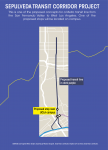Los Angeles Metro representatives discussed plans to launch a station on UCLA’s campus for a proposed rail line at a community meeting Wednesday.
Metro discussed the feasibility of different transportation concepts for the Sepulveda Transit Corridor Project, a proposed rail line intended to connect the San Fernando Valley, Los Angeles International Airport and the Westside.
Cory Zelmer, the project manager of the STC Project, said the STC aims to connect the LA County region as a whole across the Sepulveda Pass.
“What Sepulveda introduces is very much a regional service,” Zelmer said. “This is, in essence, collecting passengers from at least all the other transit lines in the valley and shuttling them through the pass to get them to the Westside or vice versa.”
Dave Sotero, a Metro spokesperson, said Metro conducted a feasibility study on the STC Project and identified a potential location for a station on the UCLA campus. The station would be near the future Purple Line Extension station in Westwood, which is planned to be completed in 2026.
“It’s a narrowing process, but right now as of this round of community meetings, we have identified a potential station on the campus,” Sotero said.
Sotero added Metro is considering adding a stop on campus because studies have shown that UCLA has a high volume of traffic.
“I’ve seen numbers of 50,000 people a day travel to the campus so it’s a huge generator of trips and it’s a huge destination for people throughout the LA County area,” Sotero said. “So this project is proposed to help people go where they need to go, and UCLA is certainly a key destination along this corridor.”
Sotero said building the transit line over the Sepulveda Pass, a mountain pass which goes through the Santa Monica Mountains that divides San Fernando Valley and the Westside, would be challenging, but necessary to reduce traffic.
“It’s a critical need,” Sotero said. “If you look at a map of this area, there’s only one direct freeway connection between the Westside and the Valley, which is the dreaded 405.”
Sotero said the STC would help reduce transit times from San Fernando Valley to the Westside from nearly two hours in heavy traffic to less than half an hour.
“What we’re finding through this feasibility study is that you could shave a lot of time off this commute,” Sotero said. “Driving could take up to two hours for a trip in the morning, whereas it could take you 15 to 25 minutes on a high-capacity transit line.”
Sotero said while it is difficult to predict fares for the proposed train line, he does not think it will cost very much for students.
“This would be a part of the Metro system,” Sotero said. “We have discounted fares for students, and if there is some sort of adjustment to the fares, I don’t anticipate it will be a high price anyway for UCLA students.”
Sotero said Metro is currently considering several rail line concepts to find the most effective means of travel.
“One concept we’re looking at is the heavy rail concept and the other is the monorail transit concept,” Sotero said. “Both of them have their trade-offs in terms of benefits and challenges.”
Sotero said the heavy-rail transit and monorail concepts would include above ground transport, which could be challenging to construct in heavily populated areas along the pass.
“There are challenges associated with doing aerial structures in a close area like the Sepulveda Pass where there’s not a lot of room to build such structures,” Sotero said.
Zachary Pizzo, a San Fernando Valley resident who attended the meeting, said he thinks the heavy rail concept would better serve the community than the monorail concept.
“The speed of going from the Valley to the Westside is important for growing the project’s functionality,” Pizzo said. “I think the use of the heavy rail allows for more expansion versus the monorail.”
Sotero said the Metro aims to complete the STC by 2035 using revenue from Measure M, a sales tax to raise money for public transportation and roads.
“This particular project is scheduled for completion in 2035 under the Measure M ordinance,” Sotero said. “We’re trying to build faster than that and we’re looking at ways we could more quickly build the project; a potential way we could do that is with a public-private partnership.”
Zelmer said a portion of the project, the Westside-Valley section, is eligible for accelerated construction for the 2028 Olympic and Paralympic games under the Metro’s Twenty-Eight by ’28 Initiative. This initiative aims to provide 28 Metro projects with additional resources for accelerated completion by 2028.
